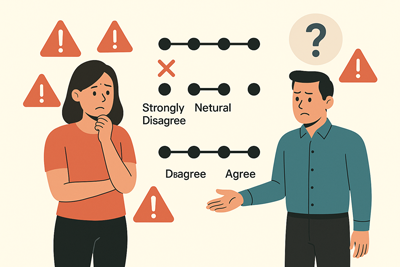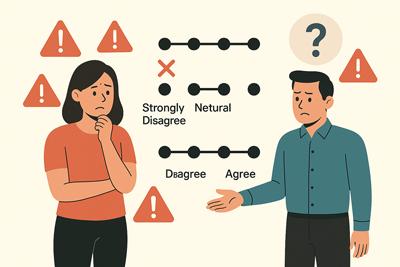Common Mistakes When Using the Likert Scale
 The Likert scale is one of the most reliable tools in modern survey design. It allows researchers, HR teams, and marketers to measure opinions and attitudes with simplicity and accuracy. Yet, even though it’s easy to use, many organizations fall into subtle traps that can distort results and undermine credibility.
The Likert scale is one of the most reliable tools in modern survey design. It allows researchers, HR teams, and marketers to measure opinions and attitudes with simplicity and accuracy. Yet, even though it’s easy to use, many organizations fall into subtle traps that can distort results and undermine credibility.
Inaccurate Likert data doesn’t just waste time — it can lead to wrong conclusions about employee satisfaction, customer experience, or market sentiment. Let us discus the most common mistakes people make when designing, distributing, and analyzing Likert-based surveys — and how you can avoid them.
Common Mistakes to Avoid with Likert Scale
Here are some common mistakes to avoid while using a likert scale for your survey.
1. Writing Double-Barreled or Vague Statements
One of the biggest issues in survey design is asking about two ideas in one statement. For example:
“The website and the app are both easy to use.”
If a respondent finds the website easy but the app frustrating, they won’t know how to answer. Each Likert item should focus on a single, specific statement. Instead, write:
“The website is easy to use.”
“The mobile app is easy to use.”
Similarly, avoid vague statements like “Customer service is good.” Be specific — “Customer service responds quickly to my inquiries” is measurable, testable, and clearer.
2. Using Inconsistent Scale Directions
Another common mistake is flipping the direction of your scale from one question to another. For example:
Q1: 1 = Strongly Disagree → 5 = Strongly Agree
Q2: 1 = Strongly Agree → 5 = Strongly Disagree
This inconsistency confuses respondents and can completely invalidate your analysis. Always maintain a consistent order for response options throughout the survey.
Consistency helps participants answer more confidently and prevents accidental inversions during analysis.
3. Overcomplicating the Scale (Too Many Points)
While it might seem that more options lead to more accurate data, adding too many scale points can overwhelm respondents. A 10-point scale, for example, forces people to make overly fine distinctions that don’t reflect real differences in sentiment.
Research consistently shows that a 5-point Likert scale or a 7-point Likert scale offers the best balance between simplicity and nuance. These formats are easy to interpret and produce statistically reliable results.
4. Failing to Provide Balanced Response Options
Balance is essential in Likert design. A scale that leans too heavily toward one side — such as offering more positive than negative options — introduces response bias. For example:
Very Satisfied
Satisfied
Somewhat Satisfied
Neutral
This scale has no negative options, which means you’re unintentionally guiding respondents toward positive answers. The fix is simple: ensure there are equal positive and negative choices with a clear neutral midpoint.
Balance allows your survey to reflect reality instead of your assumptions.
5. Ignoring Neutrality or Overusing It
The neutral option (“Neither Agree nor Disagree”) can be a valuable midpoint, but its misuse can weaken your results. Too many neutral responses may indicate unclear questions or participant fatigue. On the other hand, removing neutrality altogether (creating a 4-point forced-choice scale) can push uncertain respondents into making inaccurate selections.
The key is to decide strategically:
Use neutral options when you want honest, balanced opinions.
Remove them when you want respondents to take a definitive stance.
6. Mixing Positive and Negative Phrasing Without Balance
It’s good practice to include both positively and negatively worded statements in a survey to prevent respondents from mindlessly agreeing with everything — a bias known as acquiescence bias. However, the mistake many designers make is overcorrecting by inserting too many negative items.
For instance:
“I enjoy working with my colleagues.” (positive)
“My workload is unmanageable.” (negative)
“The company does not communicate effectively.” (negative)
When there are too many negatively framed questions, respondents can become frustrated or confused, leading to inconsistent answers. Aim for a balanced mix of both directions to maintain reliability.
To understand how agreement patterns influence results, see How to Interpret Likert Scale Responses Accurately.
7. Using Ambiguous Labels
Labels such as “Good,” “Okay,” or “Bad” can mean different things to different people. Without clear definitions, data becomes unreliable. The Likert scale works best with specific, action-oriented labels that clearly indicate intensity — like “Strongly Agree” or “Strongly Disagree.”
This linguistic clarity improves both the reliability of your survey and the quality of your analysis.
When in doubt, choose consistent labeling conventions across every question. The more predictable the format, the easier it is for respondents to engage honestly.
8. Not Testing or Validating the Survey
Even experienced researchers sometimes skip pilot testing, assuming their Likert survey is “simple enough.” Yet, even minor wording or formatting issues can produce skewed data.
Before launching a large-scale survey, test it with a small pilot group to ensure all questions are clear, unbiased, and interpreted correctly. Observe where respondents hesitate or misunderstand, then adjust accordingly.
Pilot testing also helps verify that your data analysis pipeline (for example, scoring or coding) functions as expected.
9. Treating Ordinal Data as Interval Data Without Caution
Likert data is ordinal, meaning it represents ranked categories, not exact numeric intervals. Treating the difference between “Agree” and “Strongly Agree” as mathematically equal can lead to misleading results.
While it’s common to calculate averages, remember that these numbers represent trends, not precise measurements.
When reporting, use phrases like “The average satisfaction level is high” rather than “The average score increased by 0.25.”
10. Ignoring Cultural or Linguistic Context
Words like “Strongly Agree” may not carry the same weight across different languages or cultures. In some societies, respondents avoid extreme options out of politeness or modesty. Others might interpret “Neutral” as indifference rather than balance.
When surveying international audiences, adapt your scales to local nuances. Translate questions carefully, test across cultural contexts, and use labels that feel natural in each language. This ensures your Likert scale data reflects genuine sentiment rather than cultural bias.
11. Neglecting to Visualize Results
Even accurate data loses impact if poorly presented. Many researchers limit their reports to tables or averages when visualization can reveal much more.
Use stacked bar charts, heatmaps, or diverging scales to highlight how responses spread across categories. Visualization not only enhances understanding but also helps stakeholders grasp insights quickly.
12. Forgetting to Align Questions With Objectives
Finally, the most fundamental mistake is forgetting why you’re asking the questions in the first place. Every Likert item should tie back to a clear research goal — whether you’re measuring satisfaction, trust, or engagement.
Before adding a question, ask yourself: “What decision will this data help me make?”
If there’s no clear answer, the question doesn’t belong in your survey.
Alignment keeps your research focused, your data clean, and your results meaningful.
Final Thoughts
The Likert scale is one of the simplest yet most powerful instruments in research — but only when applied correctly. Poor design or interpretation can lead to misleading conclusions, while careful planning ensures your data truly reflects reality.
By avoiding these common mistakes — from inconsistent scales to untested phrasing — you’ll collect cleaner, more accurate, and more trustworthy data.


